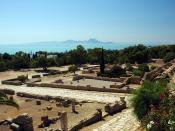Carthage- What Really Happened?
Carthage, inventers of the alphabet, leading navigators, a civilization that thrived on its trade and once rivaling Rome in advancement, now steeped in mystery.
The Pheonicians were completely destroyed by their archenemies the Romans in the Third Punic in 146BC and with all written traces of Carthage obliterated, there is no trace of their own account of their lifestyle before the Romans. The only source left of Carthaginian history is from their enemies, therefore it is hard to define the truth from the negative rumors and propaganda in Greek and Latin literature. One of the most profound mysteries is the question of whether the legend of the Phoenician ritual of sacrificing their infants was true.
In Sicily, when 6000 urns were excavated in a Phoenician Tophet, containing cremated remains of infants, the archaeological society divided. Some believed that the Tophet was just the sacred resting place for the still-born and children who died in early infancy, while others argued that this was the evidence to support the detailed Roman and Greek descriptions of the Phoenician religious ritual of sacrificing their infants to appease their bloody-thirsty gods in times of crisis.
The evidence that has been used to support both sides is ambiguous and open to interpretation.
Firstly, the written sources. While there are written detailed accounts of the child sacrifices in history by classical historians such Kleitarchos, Diodorus and Tertullian, with similar details, there are also contemporary Roman historians such as Livy and also Polybius (who was present when Carthage was destroyed in 146BC.) who, despite their dislike of Carthage, make no mention of child sacrifices. Some historians interpret this as that the accounts seem to have only come from a few classical historians who are not regarded as very credible while others point out that...


